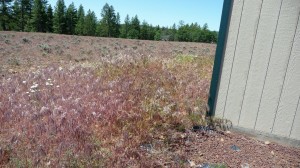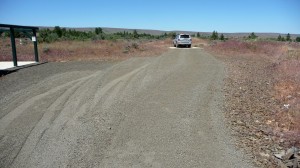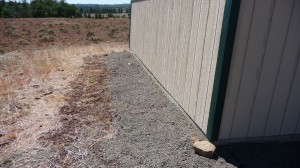Thanks to a cloudy May and certain personal obligations, I was only able to spend one night at Zephyr Ridge Observatory since my last report. I am happy to say that Mother Nature cooperated and provided excellent conditions, so my journey was not in vain. Conditions were clear and calm, and Sky Meter readings averaged 21.52 mag/arcsec2.
I used both my 20” Obsession reflector and my 4” Borg refractor. The refractor is mounted higher than my Obsession, and is easy to move. So, I often use the refractor to observe low altitude objects for which the Obsession is obstructed by the south wall of my observatory. Also, the refractor is a better instrument to use for extended objects, such as large star clusters, and on this night I enjoyed very nice views of M6 and M7 in Scorpius.
I took another look at supernova SN 2011by, which I discussed at length in my previous post. This time my observation had formal purpose, as I was able to provide a magnitude estimate for the American Association of Variable Star Observers (http://www.aavso.org/). The supernova seems to be fading now.
Two other noteworthy observations bear mentioning. I made a strong attempt to observe the globular cluster Palomar 15, and, as my notes indicate, I feel certain I detected something, even though what I saw was at the very limit of my telescope and eyes. The Palomar globulars are a well-known collection of very challenging clusters, and Palomar 15 is one of the most difficult of the set. Here’s a link to a nice web site created by another observer: http://www.deepsky-visuell.de/Projekte/PalomarGC_E.htm Large aperture and a dark site are required for these!
The other observation I would like to single out is the galaxy cluster Hickson 61, the so-called Box Galaxies (or just The Box). This is a tight grouping of four galaxies arranged in a rectangular shape. It is a very nice group, as the four members are of varying shapes and sizes. Recommended for moderate to large aperture scopes.
That’s all for now. I am hoping to make a trip to Zephyr Ridge within the next week, whether permitting.
Denis
Observing Notes
To avoid confusion, I separate my observations into two sets, one for each telescope. Otherwise the notes are in chronological order.
20” Obsession Reflector
6/3/2011 11:43 PM
SN 2011by (NGC3972) Supernova/Galaxy UMa Mag 13
RA 11h55m45s Dec +55°19’12” Size 4’
This was an observation of supernova SN 2011by, which I discovered on April 30, four days after the original discovery. The estimate was made at 98x. I used an AAVSO (http://www.aavso.org/) chart and referenced three stars: a 14.3 star roughly south of the SN, a 14.2 star NW of the SN, and a 13.9 star roughly NE of the SN. My magnitude estimate is 14.2. The presence of the halo of NGC3972 made the estimate more difficult, as defocusing the star was not possible, but I spent considerable time and am comfortable with my estimate.
6/3/2011 11:53 PM
NGC3991 Group Galaxy Cluster UMa Mag 13.2
RA 11h57m31s Dec +32°20’14” Sep 3.9’
This is a nice, easy group and all galaxies fit into the field of view at 363x. The northernmost member, NGC3991, is the most interesting galaxy in the group, as it was an elongated streak with a prominent knot on the north end of the long axis. According to my map, there is another galaxy at this location, UGC6933, and so the apparent knot is either a feature of NGC3991 or is due to light from UGC6933. There are two bright stars near NGC3991, one just north of the halo and another slightly west of that one. The other two galaxies are located SE of NGC3991. The larger galaxy, NGC3995, has a large elongated halo with definite core brightening and a stellar nucleus. The halo appeared irregular – rather blotchy. NGC3994 is much smaller and had a bright core and a very small and slightly elongated halo oriented N-S. This galaxy appeared to be the brightest of the three. There is a faint star a couple of arcminutes west of NGC3994 that is not shown on my map. There are some very bright stars to the east of the galaxy group, which I moved out of the field of view to make this observation more effective.
6/4/2011 12:05 AM
Hickson 60 Galaxy Cluster UMa Mag 13.4
RA 12h03m05s Dec +51°41’35” Sep 2.3’
This group is extremely difficult. I used a map to find the precise location, and by slewing the scope back and forth slowly and using averted vision I was only able to detect a vague hint of light at 363x. Once I thought I saw a focused point of light in the region, but for the most part there was only just an extremely faint glow. I detected evidence of something, but by no means was I able to confirm distinct galaxies. It seems this group is at the very limit of my eyes and equipment.
6/4/2011 12:42 AM
Hickson 61 (Box Galaxies) Galaxy Cluster Com Mag 9.9
RA 12h12m24s Dec +29°10’40” Sep 3.8’
At 363x, this is an excellent group. The four galaxies formed a rectangular arrangement, supporting the “Box Galaxies” common name. NGC4169 is on the SW corner of the box, and is the brightest of the group, with a bright nonstellar core and small, elongated halo. The SE corner galaxy, NGC4174, is even smaller, and has a bright core with a stellar nucleus. The halo is quite small and with averted vision I detected slight elongation. The northern galaxies are larger and more diffuse. The easternmost of the pair, NGC4175, is an elongated streak with only a little brightening in the core area. Finally, the western galaxy, NGC4173, is the largest of the group. It has lower surface brightness compared to the others, and presents as a large, elongated hazy glow.
6/4/2011 12:51 AM
NGC4613/4614/4615 Galaxy Cluster Com Mag 15
RA 12h41m29s Dec +26°05’18” Sep 2.7’
At 363x, this is a tight grouping which all fit in the field of view. The trio is rather faint as a whole, but all are visible. The southernmost member, NGC4614, presents as a small, roughly circular halo with a stellar nucleus. There is a bright star just to the west. North of this galaxy is NGC4615, which was a hazy, elongated glow with no apparent central brightening. It is the largest of the three. Finally, the northernmost member is NGC4613. This was just a faint stellar pinpoint with a tiny bit of haze around it. The stellar pinpoint was elusive; I saw it initially, and then could not see it and after careful study I was ready to discount my initial sighting – when I glimpsed it again!
6/4/2011 1:19 AM
Palomar 15 Globular Cluster Oph Mag 14.2
RA 17h00m02s Dec -00°32’31” Size 4.2′
This is an extremely difficult object. I used a map from Voyager software to pinpoint the precise location. At 98x and 212x, I was unable to see anything. However, at 363x I was able to detect a faint glow that seemed “attached” to a pair of stars oriented roughly N-S. I used averted vision and gentle slewing of the scope to detect the glow. I was unable to consistently hold it in view, but compared to the views at lower powers, I felt that at 363x I was detecting a faint bit of light. This object is at the limit of my instrument and my eyes.
6/4/2011 2:44 AM
NGC6644 Planetary Nebula Sgr Mag 12
RA 18h32m35s Dec -25°07’44” Size 0.1’
After observing several objects with my Borg refractor, I returned to the Obsession for one final observation before ending the session. Observed at 212x. This Planetary Nebula was just barely above the south wall. I used a map to get the precise location. It forms a nice triangle with two bright stars to the east, and all three stars fit comfortably in the field of view. The nebula is stellar, and clearly dimmer than the two companion stars just mentioned. I inserted an OIII filter, and this caused the companion stars to dim – whereas NGC6644 did not – so that now the three members of the triangle were of comparable brightness. This offers further confirmation of the true nature of the object, confirming my siting.
4” Borg Refractor
6/4/2011 1:11 AM
NGC6304 Globular Cluster Oph Mag 8.4
RA 17h14m33s Dec -29°27’44” Size 6.8’
Very low altitude view. Observed at 128x using 5mm Radian eyepiece. This globular is moderately bright and of decent size at this magnification. It appeared as a roughly circular glow with a little brightening towards the core. No stars resolved. Two prominent field stars are on either side of the cluster, approximately east and west.
6/4/2011 1:26 AM
NGC6405 (M6) Butterfly Cluster Open Cluster Sco Mag 4.5
RA 17h40m06s Dec -32°13’00” Size 15.0′
Observed at 53x. First time for this cluster with the Borg, and the view was quite beautiful. It is large and very bright, with at least 35 stars resolved. The butterfly shape was easy to see; the name is well deserved.
6/4/2011 1:28 AM
NGC6475 (M7) Open Cluster Sco Mag 3.5
RA 17h53m54s Dec -34°49’00” Size 80′
Observed at 53x. This is a brilliant and beautiful cluster, and is also very large. I could resolve 40-50 members easily, and most of these were very bright stars. It has a central region that seemed denser than the more scattered perimeter, and within this central area there are a couple of star chains, each of which contains 5 bright stars, one of which appeared to be a double. A fine sight.
6/4/2011 2:05 AM
NGC6522 and NGC6528 Globular Clusters Sgr Mag 8.27, 9.60
RA 18h03m35s Dec -30°02’06” (6522) Size 16.4’, 16.6’
Very low altitude. I was able to view NGC6522 and NGC6528 in the same field, and I verified the clusters with a map. The brighter cluster is NGC6522, which was nevertheless a dim hazy spot with slight brightening towards the center. A bright field star was seen to the north, with a fainter star on the same line, but nearer the cluster. NGC6528 was an even dimmer glow with a little brightening towards the center. It seemed slightly smaller than NGC6522. No stars resolved in either cluster.
6/4/2011 2:13 AM
NGC6569 and NGC6558 Globular Clusters Sgr Mag 8.7, 9.26
RA 18h13m39s Dec -31°49’35” (6569) Size 7.0’, 10.4’
Observed at 53x. Very low altitude view. NGC6569 appeared as a faint, roughly circular glow with slight brightening towards the center. It was small and I could not resolve any stars. There is a bright field star to the south, with a fainter one on the same line and nearer the cluster. NGC6558 is nearby and was quite a challenge for this instrument, but I was able to see it with effort. It is located just south of a moderately bright star, and I was only able to see a very faint glow by gently moving the scope back and forth.
6/4/2011 2:22 AM
NGC6624 Globular Cluster Sgr Mag 8.0
RA 18h23m40s Dec -30°21’40” Size 20.6’
Another very low altitude globular cluster, viewed at 53x. This cluster is fairly bright, appearing as a small glow with a bright core. No stars resolved. A faint field star was barely visible just off the halo to the west. Two others were seen to the NE and another to the north. This cluster would probably be a nice sight in the Obsession, but it is too low in the sky for me to clear the observatory south wall.
6/4/2011 2:29 AM
NGC6637 (M69) Globular Cluster Sgr Mag. 7.63
RA 18h31m24s Dec -32°21’00” Size 8.3′
Another low altitude Sagittarius globular, and I again used the 4″ Borg refractor at 53x. This cluster is bright and easy to see. The halo was fairly small at this magnification, and there was obvious brightening in the core. No stars resolved. There is a prominent field star to the NNW.



